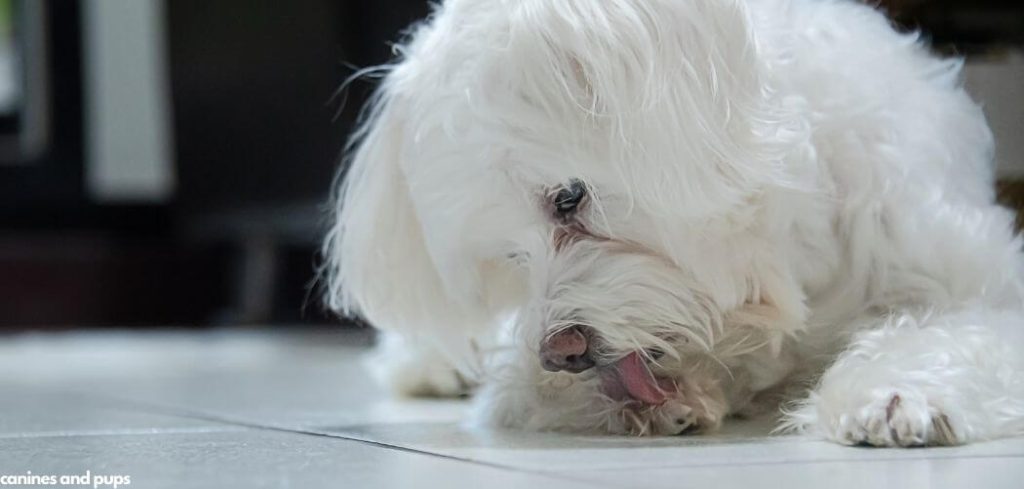During winter, some dogs exhibit a concerning behavior: constant paw licking. While grooming is natural, persistent licking during colder months may indicate discomfort caused by underlying health issues.
Left untreated, this behavior can lead to skin irritation, infections, and increased pain.
We outline the common reasons why a dog may constantly lick its paws in winter, what you can do at home, and when to seek veterinary help.
Dog Licking Paws Constantly in Winter — Why It Happens
Dogs licking their paws constantly in winter are often responding to environmental irritants, dryness, or underlying medical conditions. Cold weather, snow, ice, and de-icing chemicals can irritate paw pads. Also, allergies, fungal or bacterial infections, parasites, arthritis, or anxiety can trigger licking.
This repetitive behavior can worsen over time, causing redness, sores, and secondary infections, highlighting the need for timely intervention.

Dog Licking Paws Constantly in Winter: Common Causes
Dry and Cracked Paw Pads
Winter air is dry, and exposure to cold surfaces can cause paw pads to crack. Licking is a natural response to soothe discomfort and prevent further damage.
Owners may notice rough, cracked, or flaky paw pads. Continuous licking can exacerbate the cracking, increasing the risk of infection. Applying veterinarian-approved paw balms or moisturizers and limiting exposure to harsh conditions helps protect paw health.
Read more: Dog Licking Front Paws Excessively at Night (Causes and solutions)
Exposure to Salt and De-Icing Chemicals
Salt and chemicals used on sidewalks and roads can irritate paw skin. Dogs walking outside during winter may ingest these substances while licking, which can cause additional gastrointestinal distress.
Signs include redness, swelling, burning sensations, or a salty residue on the paws. Thoroughly rinsing paws after walks and using protective booties can reduce exposure and irritation, preventing complications.
Allergies
Some dogs experience seasonal allergies that worsen during winter. Indoor allergens such as dust mites, mold, or cleaning chemicals may trigger paw licking, especially if the dog spends more time indoors.
Redness, itching, and hair loss around the paws are common signs. Persistent licking can lead to skin infections and discomfort. Managing indoor allergens, dietary adjustments, and veterinary-prescribed treatments can alleviate symptoms.
Yeast or Bacterial Infections
Moisture trapped in fur or between toes can promote yeast and bacterial infections, even in winter. Licking may increase as dogs attempt to relieve itching or burning caused by these infections.
Symptoms include foul odor, greasy or crusty fur, redness, and inflammation. Untreated infections can spread and become severe. Treatment often involves medicated shampoos, antifungal or antibiotic ointments, and sometimes oral medications prescribed by a veterinarian.
Anxiety or Behavioral Issues
Winter confinement due to cold weather can increase boredom or anxiety, leading to compulsive paw licking. Dogs may lick as a self-soothing mechanism when stressed or understimulated.
Behavioral signs include repeated licking without visible irritation, pacing, or restlessness. Providing mental stimulation, interactive toys, exercise indoors, and calming routines can reduce compulsive licking.
Arthritis or Joint Discomfort
Cold weather can exacerbate joint pain in older dogs or those with arthritis. Paw licking may occur as a response to discomfort in the legs or hips, serving as a self-soothing behavior.
Indicators include stiffness, limping, reluctance to move, or decreased activity. Managing arthritis with pain relief, joint supplements, and gentle indoor exercise can alleviate discomfort and reduce licking behaviors.
Read more: Dog Excessively Licking Back Paws (Why it happens and what to do)
What to Do If Your Dog Is Licking Their Paws Constantly in Winter
Inspect your dog’s paws for dryness, cracks, redness, swelling, or embedded debris. Clean paws gently with lukewarm water and dry thoroughly. Applying a veterinarian-approved paw balm can soothe minor cracks and protect against cold exposure.
Rinse paws after walks to remove salt, chemicals, and snow. Consider using protective booties to limit direct contact with ice and de-icing substances.
For anxiety-related licking, increase indoor playtime, interactive toys, and consistent routines to reduce stress. If paw licking persists or worsens, consult your veterinarian to identify and treat underlying conditions.
When to Call or Visit Your Vet
Seek veterinary attention if your dog’s paw licking results in open sores, bleeding, or severe redness.
Look for signs of infection such as swelling, foul odor, or discharge. Persistent limping, stiffness, or behavioral changes alongside licking also warrants evaluation.
Other signs include decreased appetite, fever, or lethargy. A veterinarian can diagnose causes such as infections, allergies, parasites, or arthritis, and recommend treatments like medications, dietary changes, or behavioral interventions. Prompt care prevents further complications and promotes healing.
Read more: Dog licking paws excessively (When to worry)
Key Takeaway
Constant paw licking in winter can indicate dryness, environmental irritation, infections, allergies, anxiety, or joint pain.
Early intervention, such as cleaning paws, protecting them from harsh conditions, providing mental stimulation, and consulting a veterinarian, helps prevent complications.
Understanding and addressing the underlying cause ensures your dog remains comfortable, healthy, and happy throughout the winter months.
